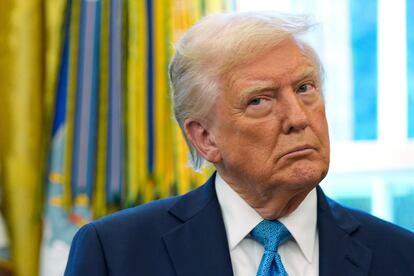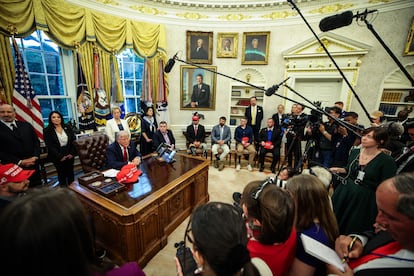The economy puts the brakes on Trump
Pressure from markets and businesses is forcing the US president to back down on issues such as tariffs and his desire to fire the head of the Federal Reserve


Donald Trump has always liked to use the stock market as a barometer of his success. The signals the market has emitted since his return to the White House have been discouraging the U.S. president’s administration, especially in terms of the trade war. It’s not just the stock market: the bond market and the dollar’s price have reflected the growing distrust in U.S. assets that Trump has generated. Along with the courts, the economy is taking charge of reining in some of the president’s decisions. Pressure from businesses and investors has led Trump to soften tariffs and appear more conciliatory toward China. Furthermore, a new market scare has led him to say he has no intention of firing Federal Reserve chair Jerome Powell, just days after calling for his dismissal.
“I used to think that if there was reincarnation, I wanted to come back as the president or the pope or as a .400 baseball hitter. But now I would like to come back as the bond market. You can intimidate everybody.” This quote is from James Carville, Bill Clinton’s advisor, who saw how market pressure forced him to change his economic policy. The concept of “bond vigilantes” actually predates it. It was coined by economist Ed Yardeni, referring to investors who sell Treasury bonds, driving up the required yield, when they lose confidence in a country’s economic and fiscal policy. The bond vigilantes forced Clinton to back down, forced Liz Truss to resign as UK prime minister, and, via risk premiums, in Spain forced José Luis Rodríguez Zapatero to implement harsh cuts, and Mariano Rajoy to request a financial bailout from the European institutions.
Trump isn’t easily intimidated, but the rise in U.S. bond yields, along with the stock market crash and the depreciation of the dollar, were the triggers for his declaration of a 90-day partial truce in the trade war on April 9. The Republican admitted that investors were “getting a little yippy.” “I thought that people were jumping a little bit out of line. They’re getting a little bit… afraid,” he said, celebrating how “beautiful” the market looked after the truce.
The situation has been repeated in the last week. Just days after suggesting he was considering removing the Federal Reserve chair, he asserted Tuesday that he has no intention of doing so. “The press is jumping the gun on things. No, I have no intention of firing him,” Trump said. Meanwhile, threats to the central bank’s independence have heightened distrust in U.S. assets and driven the dollar to a three-year low, with further declines on Wall Street and in the bond markets.

Moderate the trade war
The market punishment and the rapidly deteriorating economic outlook have also forced Trump and his team to soften the tone in the trade war with China. The current tariffs, at 145% on Chinese imports (and 125% on Chinese purchases of U.S. goods), “are not sustainable,” Treasury Secretary Scott Bessent said Tuesday at a closed-door event with bankers. Trump himself later endorsed the idea in the Oval Office. He said the steep tariffs “will come down substantially, but they won’t be zero. It won’t be anywhere near that high,” he insisted.
The Wall Street Journal reported Wednesday that the White House is considering a substantial reduction in tariffs on China, to levels of approximately 50% to 65%, in a combination that could include tariffs of 35% on goods the U.S. doesn’t consider strategic and 100% on those for which there is interest in special protection. This would be a way to begin the de-escalation process, but the president hasn’t made a decision.
On Wednesday, without abandoning his protectionist rhetoric, Trump once again extended his hand: “We’re going to have a fair deal with China,” he affirmed. Bessent, speaking to the press after a speech at a Washington hotel, offered a mixed bag. Asked if there was a unilateral offer from the president to de-escalate the trade war, he said “absolutely not.” At the same time, he left the door open to a reduction by both sides: “I don’t think either side believes the current tariff levels are sustainable, so I wouldn’t be surprised if they were lowered mutually,” he stated, asserting that there is “an opportunity for a great deal.”
In his first term, Trump was the first president in nearly a century to destroy jobs. He could have blamed the pandemic, but the crisis he now threatens to unleash is entirely self-inflicted. Fears of a financial crisis leading to a deep recession have spread within the White House in recent weeks, a scenario they internally call “1929,” according to The New York Times, in reference to the stock market crash that year that sparked the Great Depression.
It’s not just the markets. Automakers succeeded in getting Trump to ease tariffs on cars and components from Mexico and Canada after warning of the risk of exorbitant prices. The idea of iPhones costing over $2,000 and pressure from Apple preceded the tariff exemptions on cell phones, tablets, and computers. This week, executives from large retailers such as Walmart, Target, and Home Depot, major importers of Chinese products, visited the White House, warning of the risk of price hikes and empty shelves. Trade policy thus becomes an influence peddling from which small and medium-sized businesses are excluded. It’s the large ones, those that helped Trump raise $239 million for his inauguration festivities, that have access to the president.
Sign up for our weekly newsletter to get more English-language news coverage from EL PAÍS USA Edition
Tu suscripción se está usando en otro dispositivo
¿Quieres añadir otro usuario a tu suscripción?
Si continúas leyendo en este dispositivo, no se podrá leer en el otro.
FlechaTu suscripción se está usando en otro dispositivo y solo puedes acceder a EL PAÍS desde un dispositivo a la vez.
Si quieres compartir tu cuenta, cambia tu suscripción a la modalidad Premium, así podrás añadir otro usuario. Cada uno accederá con su propia cuenta de email, lo que os permitirá personalizar vuestra experiencia en EL PAÍS.
¿Tienes una suscripción de empresa? Accede aquí para contratar más cuentas.
En el caso de no saber quién está usando tu cuenta, te recomendamos cambiar tu contraseña aquí.
Si decides continuar compartiendo tu cuenta, este mensaje se mostrará en tu dispositivo y en el de la otra persona que está usando tu cuenta de forma indefinida, afectando a tu experiencia de lectura. Puedes consultar aquí los términos y condiciones de la suscripción digital.
More information
Archived In
Últimas noticias
Most viewed
- Cartels in Mexico take a leap forward with narco-drones: ‘It is criminal groups that are leading the innovation race’
- Christian Louboutin: ‘Young people don’t want to be like their parents. And if their parents wear sneakers, they’re going to look for something else’
- A mountaineer, accused of manslaughter for the death of his partner during a climb: He silenced his phone and refused a helicopter rescue
- If AI replaces workers, should it also pay taxes?
- ‘We are dying’: Cuba sinks into a health crisis amid medicine shortages and misdiagnosis










































